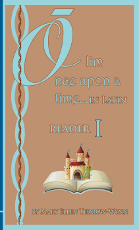Olim, Once Upon a Time, In Latin is the title of this Latin series for grades two through six. The series has a reader and workbook for each of ten levels.
Using a unique approach, author Mary Ellen Tedrow-Wynn uses fables, parables, and Bible stories as the primary vehicles for teaching Latin. In each reader, stories are presented first in English then in Latin. Delightful, pencil-drawn illustrations throughout the readers enhance the stories and give students visual clues as they read the stories in either English or Latin.
The Olim series teaches Latin grammar, but this is secondary to reading and translating the stories in the readers. Grammar is taught explicitly only in the workbooks.
The readers do not limit vocabulary and sentence structure to only the simplest levels. For example, in the story of the “Three Little Pigs” in the first reader, there is a passage that reads, “Still nothing happened. The wolf climbed up onto the roof. He wanted to go down through the chimney and capture the pig, but the pig saw him” (p. 15). This passage, translated directly into Latin in the following story, includes past tense verbs and vocabulary not usually taught at such an early level. In addition, the course presents all five cases for nouns (although students need not learn them). Even the first workbook has a chart showing the forms for the first two declensions.
While this might sound overwhelming for young children, Tedrow-Wynn has written both readers and workbooks to allow parents to teach the grammar or skip over it in favor of what would be considered an immersion approach. In the readers, pages with stories in Latin include sidebars on every page with translations of most words used on those pages so that children can quickly look up the meaning without having to think about the grammar.
Readers include notes at the bottom of each page telling which workbook exercises should be completed. Workbook exercises require students to write translations or connect columns from English to Latin and Latin to English. Children can copy from the reader easily if they don’t recall translations and their spellings. “Digging for Treasure” clues scattered through the workbooks help students translate Bible verses Latin into English. (These verses are not in the stories.) Workbook exercises should not be overwhelming, even for younger students, if you work through them a little at a time. Answer keys are at the back of each workbook.
For children ready to learn Latin grammar, “Digging Deeper” sections in each workbook lesson teach grammatical concepts. However, students are not required to conjugate verbs or figure out declensions for nouns. The idea is that by continuous exposure and instruction, students will learn much of this through familiarity. Nevertheless, if you choose to use the grammar instruction, the courses teach quite a significant amount of Latin grammar.
The first reader includes “The Three Little Pigs,” “The Tortoise and the Hare,” and “The Crow and the Pitcher.” Reader II features the three stories: “The Good Samaritan,” “The Ant and the Chrysalis,” and “The Lost Sheep.” Reader III has only two lengthier stories, “The Lion and the Mouse” and “The Feeding of the 5000.” The fourth reader adapts the beginning of the book of Genesis to present “The History of Creating the World,” a retelling of the seven days of creation. Reader V has two biblical stories, "We Know a Tree by Its Fruit from Luke 6:43-46 and a story of Daniel from Daniel 2:1-49. The next three readers feature only one, lengthier story each: "The Prodigal Son" in the sixth reader, "David and Goliath" in the seventh, and "Daniel, Part II" (adapted from the third chapter of the book of Daniel) in the eighth reader. Reader IX is still in the works, but the series skips to Reader X which has two parables, "The Wise Man and the Foolish Man" and "The Ten Maidens." As you can see, biblical stories are included in all except the first reader.
I expect that most students who are familiar with Bible stories will enjoy reading these well-known stories in English then tackling them in Latin. The familiar content should make the task easier than if they were translating stories they have never heard.
The books all have pronunciation guides showing classical pronunciation. Audio files with the stories read in Latin (classical pronunciation) are available for $5 per book. Of course, you can skip the audio files and use ecclesiastical pronunciation if you wish.
While the Olim series is written as a stand-alone program to introduce Latin, I think it should also be useful as a supplement for those studying Latin in a different program. I also think that Latin students beyond sixth grade might enjoy tackling the Latin stories to sharpen their translation skills.
You might also be interested in companion products that fit well with the Olim series: Latin Verbs and Olim Once Upon a Time in Latin: Derivatives.















